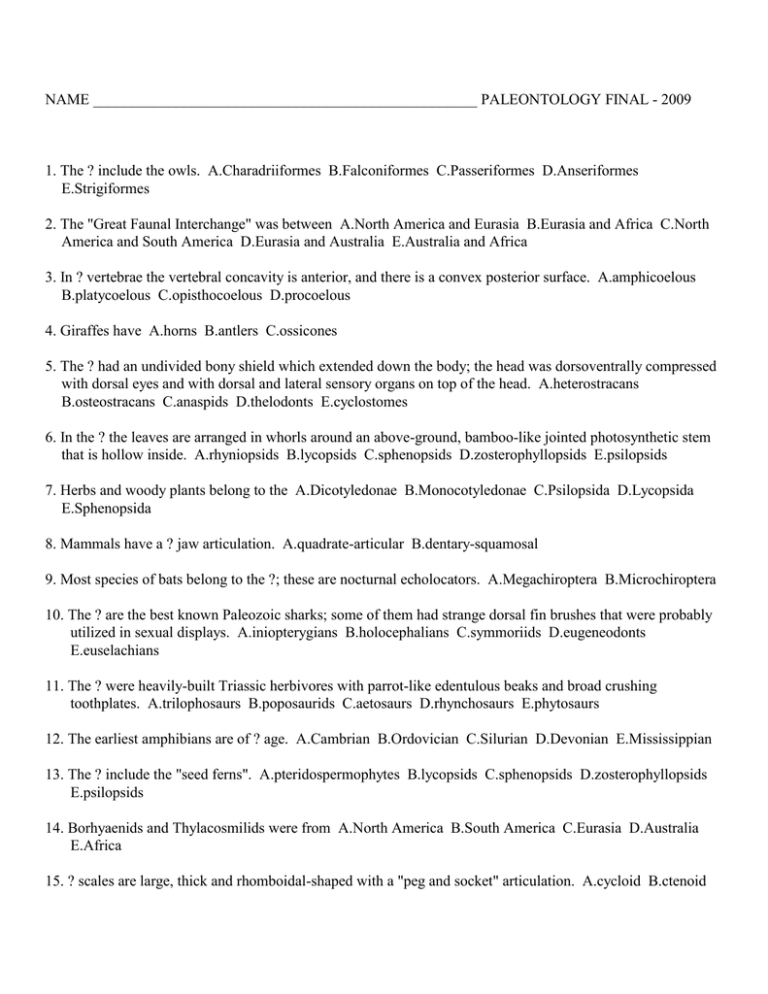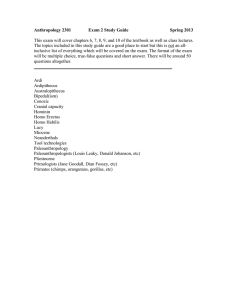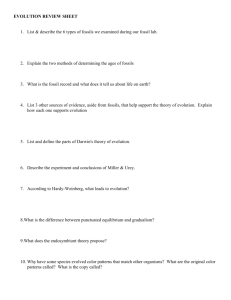NAME ___________________________________________________ PALEONTOLOGY FINAL - 2009
advertisement

NAME ___________________________________________________ PALEONTOLOGY FINAL - 2009 1. The ? include the owls. A.Charadriiformes B.Falconiformes C.Passeriformes D.Anseriformes E.Strigiformes 2. The "Great Faunal Interchange" was between A.North America and Eurasia B.Eurasia and Africa C.North America and South America D.Eurasia and Australia E.Australia and Africa 3. In ? vertebrae the vertebral concavity is anterior, and there is a convex posterior surface. A.amphicoelous B.platycoelous C.opisthocoelous D.procoelous 4. Giraffes have A.horns B.antlers C.ossicones 5. The ? had an undivided bony shield which extended down the body; the head was dorsoventrally compressed with dorsal eyes and with dorsal and lateral sensory organs on top of the head. A.heterostracans B.osteostracans C.anaspids D.thelodonts E.cyclostomes 6. In the ? the leaves are arranged in whorls around an above-ground, bamboo-like jointed photosynthetic stem that is hollow inside. A.rhyniopsids B.lycopsids C.sphenopsids D.zosterophyllopsids E.psilopsids 7. Herbs and woody plants belong to the A.Dicotyledonae B.Monocotyledonae C.Psilopsida D.Lycopsida E.Sphenopsida 8. Mammals have a ? jaw articulation. A.quadrate-articular B.dentary-squamosal 9. Most species of bats belong to the ?; these are nocturnal echolocators. A.Megachiroptera B.Microchiroptera 10. The ? are the best known Paleozoic sharks; some of them had strange dorsal fin brushes that were probably utilized in sexual displays. A.iniopterygians B.holocephalians C.symmoriids D.eugeneodonts E.euselachians 11. The ? were heavily-built Triassic herbivores with parrot-like edentulous beaks and broad crushing toothplates. A.trilophosaurs B.poposaurids C.aetosaurs D.rhynchosaurs E.phytosaurs 12. The earliest amphibians are of ? age. A.Cambrian B.Ordovician C.Silurian D.Devonian E.Mississippian 13. The ? include the "seed ferns". A.pteridospermophytes B.lycopsids C.sphenopsids D.zosterophyllopsids E.psilopsids 14. Borhyaenids and Thylacosmilids were from A.North America B.South America C.Eurasia D.Australia E.Africa 15. ? scales are large, thick and rhomboidal-shaped with a "peg and socket" articulation. A.cycloid B.ctenoid C.cosmoid D.ganoid 16. The "Turkana Boy" pertains to ?; this specimen indicates that the height of adults was over six feet with a brain size of 800 to 1050 milliliters. A.Sahelanthropus B.Homo habilis C.Homo ergaster D.Homo rudolfensis E.Homo neanderthalensis 17. The medial/lingual cusp on upper molars is termed the A.protoconid B.paraconid C.protocone D.metacone E.paracone 18. Moles and shrews often have A.square molars due to the addition of a hypocone B.W-shaped outer walls on the upper molars 19. Ceratosaurs, carnosaurs and coelurosaurs are A.theropods B.ornithopods C.ceratopsians D.ankylosaur E.sauropods 20. The Gymnomycota, Mastigomycota and Amastigomycota are types of A.Fungi B.Rhyniopsida C.Psilopsida D.Lycopsida E.Sphenopsida 21. The ? are found only in rocks of Cretaceous age; they often had horns and large head shields. A.theropods B.ornithopods C.ceratopsians D.ankylosaurs E.sauropods 22. A ? bird foot is found in woodpeckers and parrots; there are two toes in front and two behind. A.anisodactylous B.zygodactylous 23. Bat wings are supported by ? fingers. A.1 B.2 C.3 D.4 E.5 24. In the ?, there is a septum in the auditory bulla; the external carotid has a countercurrent exchanger in the vicinity of the orbit for cooling blood entering the brain. A.canoids B.litopterns C.notoungulates D.feloids E.xenarthrans 25. The ? are megaphylls; the fronds are typically pinnately compound and circinate. A.rhyniopsids B.lycopsids C.sphenopsids D.zosterophyllopsids E.filicopsids 26. Teleosts are characterized by a ? tail. A.diphycercal B.heterocercal C.hypocercal D.homocercal 27. The "New World Monkeys", such as marmosets and cebids, are A.strepsirhines B.haplorhinines C.platyrrhines D.plesiadapiforms E.catarrhines 28. The classification of the ? especially utilizes masseter muscle attachment patterns. A.Chiroptera B.Cetacea C.Sirenia D.Primates E.Rodentia 29. In ? vertebrae the pleurocentra increase in size and become a complete ring. A.lepospondylous B.rhachitomous C.stereospondylous D.anthracosaurian 30. The first human tool culture was the A.Acheulian B.Mousterian C.Oldowan D.Perigordian E.Solutrean 31. The largest known land carnivores (or were they scavengers?) of all times belonged to the A.Proboscidea B.Sirenia C.Cetacea D.Acreodi E.Desmostylia 32. The ? has a flexible skeleton, sharp retractile claws and the carnassials are extremely well-developed. A.Canidae B.Ursidae C.Procyonidae D.Amphicyonidae E.Felidae 33. In the ? there are only 5 to 9 trunk vertebrae; there are no ribs, a urostyle is present, there are long hind limbs, and the skull forms an "open" structure. A.Urodela B.Apoda C.Anura D.Aistopoda E.Nectridia 34. The "Bear-Dogs" belonged to the A.Canidae B.Ursidae C.Procyonidae D.Amphicyonidae E.Felidae 35. Primitive artiodactyls are A.selenodont and hypsodont B.brachydont and bunodont 36. In ? there was a lower temporal opening with the postorbital and squamosal meeting above. A.euryapsids B.diapsids C.synapsids D.anapsids 37. The ? are found in rocks from Cretaceous through Eocene age; they had a rodent-like dentition with a long diastema between the procumbent incisors and grinding molar teeth. A.strepsirhines B.haplorhinines C.platyrrhines D.plesiadapiforms E.catarrhines 38. The ? have "long" and "short shoots"; the leaves are usually fan-shaped and are often deeply lobed. A.Pteridospermophytes B.Cordaitales C.Coniferales D.Ginkgoales E.Cycadophyta 39. In amphibians, reptiles and birds the major "ear bone" is the A.stapes B.malleus C.incus D.all of these bones are equally important in amphibians, reptiles and birds 40. ? were robust australopithecines. A.Australopithecus B.Homo habilis C.Homo ergaster D.Homo rudolfensis E.Paranthropus 41. In the ? the carnassials usually involve M1+2/M2+3 . A.Chiroptera B.Carnivora C.Creodonta D.Primates E.Rodentia 42. From the Paleocene until the Pliocene ? was an "island continent". A.North America B.South America C.Europe D.Asia E.Africa 43. Ophiacodonts, sphenacodonts, edaphosaurs and caseids are types of A.therapsids B.pelycosaurs C.mesosaurs D.mosasaurs E.testudines 44. The Ursidae has ? posture. A.plantigrade B.unguligrade C.digitigrade 45. The ? were Permian-age aquatic parareptiles that were used by Wegener as evidence of continental drift. A.therapsids B.pelycosaurs C.mesosaurs D.mosasaurs E.testudines 46. Most Australian marsupials are A.polyprotodont B.diprotodont 47. A palaeognathous palate is characteristic of A.ornithischian dinosaurs B.saurischian dinosaurs C.crocodiles D.ratites E.mammals 48. The Tasmanian "pouched wolf" was a A.canid B.didelphid C.borhyaenid D.notoryctid E.thylacinid 49. In ? dentition the teeth are attached to the inside of the jaw. A.acrodont B.thecodont C.pleurodont 50. Plesiosaurs and ichthyosaurs were A.euryapsids B.diapsids C.synapsids D.anapsids 51. In ? the premaxilla is freed and becomes the primary tooth-bearing element in the upper jaw; the maxilla was freed so that it could be pulled down and forward by the lower jaw as the mouth opened. A.teleosts B.chondrosteans C.sarcopterygians D.holosteans E.chondrichthyans 52. ? was a tiny island species from Indonesia; it had a Homo erectus-like morphology but may have lived as late as 18,000 years ago. A.Homo floresiensis B.Homo habilis C.Homo ergaster D.Homo rudolfensis E.Homo neanderthalensis 53. Many of the ? were freshwater sharks; the teeth had two or three cusps and they had a diphycercal caudal fin. A.eugeneodonts B.ctenacanths C.hybodonts D.neoselachians E.xenacanths 54. In the "crocodile-normal" tarsal pattern, the A.astragalus fits into a recess of the calcaneum B.calcaneum fits into a recess of the astragalus 55. The ? were often huge, armadillo-like mammals that lived from the Miocene through Pleistocene. A.bradypodids B.mylodontoids C.myrmecophagids D.glyptodonts E.pholidotans 56. The earliest vertebrates are of ? age. A.Cambrian B.Ordovician C.Silurian D.Devonian E.Mississippians 57. Deinotheres and gomphotheres belonged to the A.Proboscidea B.Sirenia C.Cetacea D.Tubulidentata E.Desmostylia 58. ? have a perforate acetabulum, an improved tarsal joint, and a digitigrade posture. A.trilophosaurs B.poposaurids C.aetosaurs D.rhynchosaurs E.dinosaurs 59. In the ? the snout is elongate and the skull is telescoped, with the maxilla sometimes touching the bones at the back of the braincase. A.Proboscidea B.Sirenia C.Cetacea D.Tubulidentata E.Desmostylia 60. Mousterian Tools were made primarily by A.Homo sapiens B.Homo habilis C.Homo ergaster D.Homo rudolfensis E.Homo neanderthalensis 61. The ? are near the ancestry of amphibians. A.coelacanths B.osteolepiforms C.dipnoans D.xenacanths E.euselachians 62. The ? were huge herbivores with powerful limbs, long tail, long neck and small head equipped with peglike or spoonshaped teeth. A.theropods B.ornithopods C.ceratopsians D.ankylosaur E.sauropods 63. In the ? the hind legs are capable of positioning anteriorly; the cheek teeth have single cusps. A.enaliarctids B.desmatophocids C.otariids D.odobenids E.phocids 64. In ? the first gill arch bears the main burden of jaw support; it is found in modern sharks and higher actinopterygians. A.autostyly B.holostyly C.hyostyly D.amphistyly 65. The ? is the food-conducting tissue of plants. A.periderm B.sporopollenin C.cambium D.xylem E.phloem 66. Which of the following would not belong to the Arctoidea? A.Canidae B.Ursidae C.Procyonidae D.Amphicyonidae E.Felidae 67. ? include the "rat-kangaroos", wallabies and true kangaroos. A.vombatids B.diprotodontids C.thylacoleonids D.macropodids E.phascolarctids 68. In pterosaurs, the flight mechanism consisted of A.digits 2 thru 5 B.fused carpal bones C.the fourth digit only 69. The ? have a "double-pulleyed astragalus". A.Cetacea B.Perissodactyla C.Proboscidea D.Xenarthra E.Artiodactyla 70. A synsacrum, pygostyle and uncinate processes on the ribs are characters found in A.lepospondyls B.anthracosaurs C.birds D.mammals E.placoderms 71. Which of the following is not a tracheophyte? A.rhyniopsid B.lycopsid C.bryophyte D.zosterophyllopsid E.psilopsid 72. Birds probably originated from ? dinosaurs. A.ornithopod B.ankylosaur C.sauropod D.theropod E.ceratopsian 73. In the ?, the ear region developed two chambers; early types had 44 low-crowned teeth and later types had a diastema with high-crowned molars with pi-shaped lophs. A.Artiodactyls B.Perissodactyls C.Notoungulates D.Litopterns E.Dinoceratans 74. The largest land mammals known were A.chalicotheres B.brontotheres C.uintatheres D.tapirs E.rhinos 75. The ? were dolphin- and shark-like Mesozoic neodiapsids; the skull was highly modified for aquatic life and they gave birth to live young in the water. A.nothosaurs B.mosasaurs C.plesiosaurs D.ichthyosaurs E.placodonts 76. ? is capable of "expansional" growth. A.cartilage B.bone C.both bone and cartilage are capable of "expansional" growth 77. The most important group of modern birds are the A.Charadriiformes B.Falconiformes C.Passeriformes D.Anseriformes E.Strigiformes 78. The egg-laying mammals belong to the A.Metatheria B.Eutheria C.Prototheria 79. The presence of prismatic cartilage, placoid scales, and claspers is characteristic of the A.acanthodians B.chondrichthyans C.actinopterygians D.placoderms E.sarcopterygians 80. The terms "tritubercular" and "tribosphenic" refers to A.reproductive modes B.jaw articulation types C.temporal openings of skull D.tooth cusp patterns E.auditory bulla morphology 81. In ? there was a holostylic jaw and most had crushing toothplates; a diphycercal tail was common in this group. A.coelacanths B.osteolepiforms C.dipnoans D.xenacanths E.euselachians 82. The ? include the baleen whales. A.Acreodi B.Archeoceti C.Odontoceti D.Ceratomorpha E.Mysticeti 83. The aistopods, nectridians and microsaurs are A.temnospondyls B.lissamphibians C.lepospondyls D.anthracosaurs E.ichthyostegids 84. ? often have a stylar shelf on the upper molars, and a twinned hypoconulid-entoconid. A.monotremes B.triconodonts C.symmetrodonts D.marsupials E.multituberculates 85. The Pleurodires and Cryptodires are types of A.therapsids B.pelycosaurs C.mesosaurs D.mosasaurs E.testudines 86. The Mylodontoidea and Megalonychoidea were A.rodents B.anteaters C.ground sloths D.pangolins E.tenrecs 87. In the ? the cheek teeth trend towards cyclic succession and there is an increase in crown volume; the second incisor teeth become enlarged. A.Proboscidea B.Sirenia C.Cetacea D.Tubulidentata E.Desmostylia 88. In the ? pelvic fins moved anteriorly, and the pectoral fin moved higher on the lateral body all. A.teleosts B.holosteans C.chondrosteans 89. The ? have a sprawling posture; they include sphenodonts and squamates. A.lepidosauromorphs B.archosauromorphs 90. The ? were "marsupial lions". A.vombatids B.diprotodontids C.thylacoleonids D.macropodids E.phascolarctids 91. Dinosaurs became extinct at the end of the A.Pennsylvanian B.Permian C.Triassic D.Jurassic E.Cretaceous 92. The flowering plants belong to the A.Anthophyta B.Rhyniopsida C.Psilopsida D.Lycopsida E.Sphenopsida 93. Many ? dug aestivation burrows; these burrows are found from the Devonian to Recent. A.coelacanths B.osteolepiforms C.dipnoans D.xenacanths E.euselachians 94. In the advanced ?, the head and trunk shields were connected by a ball-and-socket articulation; they include the arthrodires. A.acanthodians B.chondrichthyans C.actinopterygians D.placoderms E.sarcopterygians 95. The pelycosaurs and therapsids were A.anapsids B.diapsids C.euryapsids D.synapsids 96. During the Miocene ? climates developed in North America. A.drier B.wetter 97. The ? are leafless; the sporangia are kidney-shaped and are borne along the sides of the axis; this group is "H-branched". A.rhyniopsids B.lycopsids C.sphenopsids D.zosterophyllopsids E.psilopsids 98. Symmoriids and eugeneodonts were A.subterbranchialians B.elasmobranchs 99. Streptostyly involves A.sprawling posture B.erect posture C.tooth implantation D.loosening of skull bones E.reproductive modes 100. ? had a "bun-shaped" skull, a protruding face, no chin, and a large cranial capacity. A.Homo floresiensis B.Homo habilis C.Homo ergaster D.Homo rudolfensis E.Homo neanderthalensis


